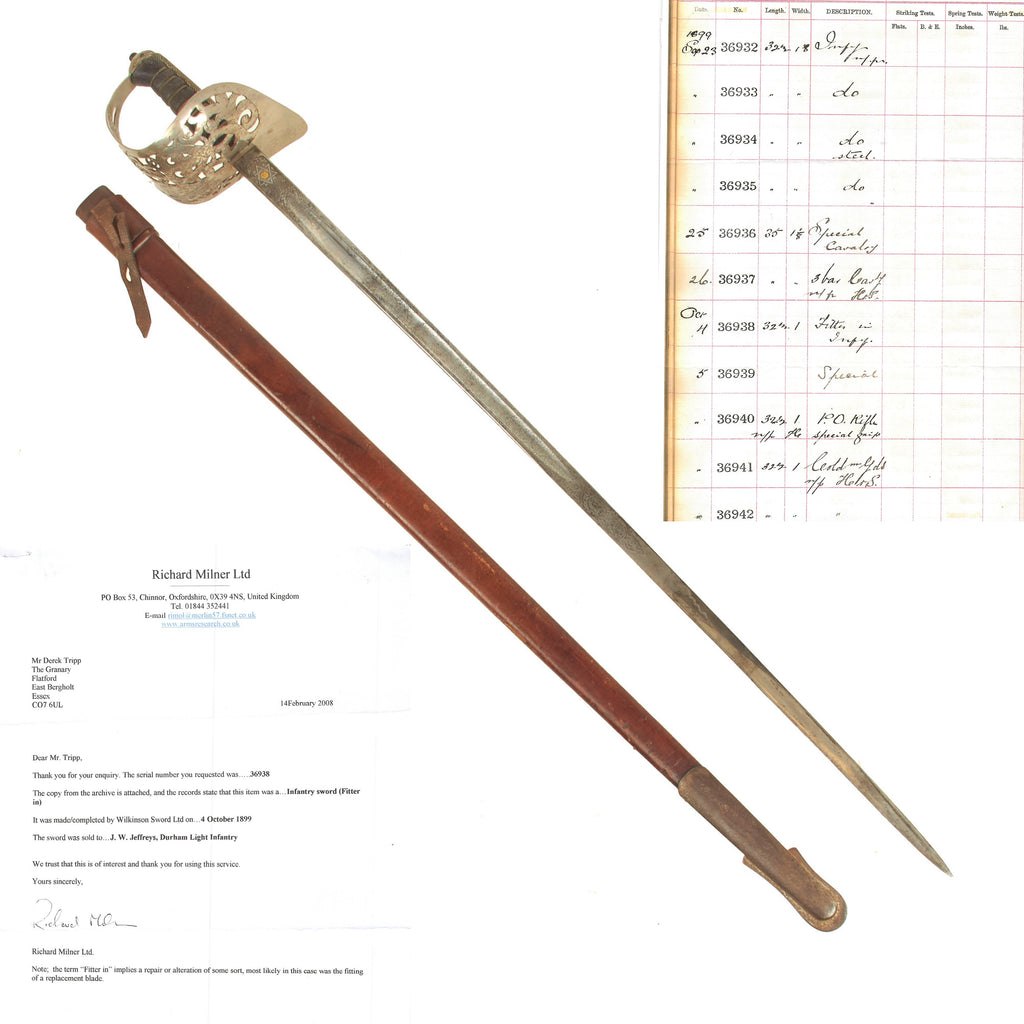Item Description
Original Item: Only One Available. The spine is engraved with the serial number 36938, which according to the WILKINSON SWORD ARCHIVE at armsresearch.co.uk and accompanied by an official document signed letter from armsresearch along with copies of the records, it states that this sword was purchased from the Wilkinson Sword Company in October 4, 1899 by the then 2nd Lieutenant John William Jeffreys, Durham Light Infantry.
We were fortunate enough to locate a “biography” of Jeffreys service on the Durham At War website:
“John William Jeffreys, the son of John and Florence Hall Jeffreys, was born at Canterton, Lyndhurst, Hampshire on 25 September 1876. He had two brothers and two sisters and went to school at Radley. He was commissioned into the Hampshire Regiment on 25 September 1895 and was promoted to lieutenant in 1897. In May 1898 he was transferred from the Militia as a 2nd lieutenant into the Durham Light Infantry (DLI) and was promoted to lieutenant in 1900. He fought in South Africa during the Boer Wars with the Mounted Infantry, being involved in the relief of Ladysmith and other actions, and was awarded the Queen’s Medal with five clasps and the King’s Medal with two clasps. In 1903 he was promoted to captain and in October 1906 he married Evelyn Katherine Douglas, daughter of Major Gordon Douglas. In 1909 they had a son, Peter John Jeffreys, who later became a brigadier in the DLI. From October 1913 to September 1915, when he was promoted to major, John was adjutant of the 1/6th Battalion Durham Light Infantry.
On 19 April 1915 he landed in France and served briefly with the 2/5th Battalion Lancashire Fusiliers before being appointed temporary lieutenant-colonel in the 6th Battalion Durham Light Infantry, which he commanded from 13 September to 20 December 1915 and from 26 April to 25 September 1916. He was mentioned in despatches on 1 January 1916 and later in the month was awarded the Distinguished Service Order (DSO). During the following three years he had several appointments as temporary and acting lieutenant-colonel in command of the 8th and 1st/9th Battalions Durham Light Infantry and the 52nd Battalion Royal West Surrey Regiment before being promoted to brevet lieutenant-colonel on 3 June 1919. He was appointed substantive lieutenant-colonel in April 1923 and from 14 February to 6 April 1927 served with the Shanghai Defence Force in command of the 2nd Battalion Durham Light Infantry. On his return to England, he went on half-pay and retired on 9 November 1927. On leaving the army he returned to Hampshire, where his wife, Evelyn, died in 1932. In June 1937 he married Muriel Primrose Shedden (nee Watson) and he died at Canterton, Lyndhurst in 1962.”
As stated he was mentioned in despatches on 1 January 1916 and later in the month was awarded the Distinguished Service Order (DSO). The DSO was awarded for meritorious or distinguished service by officers of the armed forces during wartime, typically in actual combat, serving under fire, and usually awarded to those above the rank of captain.
In the 1890s a rapid succession of regulation changes happened to British infantry officers' swords. The change was to move away from a cut and thrust saber blade and towards a specialized straight thrusting sword.
The introduction of the new thrusting blade was quickly followed by improvements to the handle and guard of the hilt, intended to provide a better grip and greater protection to the hand.
This P-1897 Officers’ sword is a wonderful example of those changes made, and is an incredible British Infantry Officers Sword. This Victorian-era infantry officer's sword features a single fullered etched blade and beautiful gothic style hilt in gilt brass. The basket is marked with the “VR” monogram for Queen Victoria. This is also seen on either side of the blade in the etching.
The blade ricasso has the standard 6 pointed star around a brass plug stamped PROVED, and the reverse bears the maker information:
HENRY
WILKINSON
PALL MALL
LONDON
Shark skin grip is complete and shows light wear. The basket retains a fair amount of patina in some spots. The blade etching and embossing shows wear from cleaning. There is very little pitting or severe wear to the blade, though there is no play in the blade at the grip.
This is a wonderful example that comes more than ready for further research and display.
The Durham Light Infantry (DLI) was a light infantry regiment of the British Army in existence from 1881 to 1968. It was formed in 1881 under the Childers Reforms by the amalgamation of the 68th (Durham) Regiment of Foot (Light Infantry) and the 106th Regiment of Foot (Bombay Light Infantry) along with the Militia and Volunteers of County Durham.
The regiment served notably in the Second Boer War, World War I and World War II, the Korean War and the Indonesia–Malaysia confrontation. During times of peace it had duty in India, China, West Germany and Cyprus.
In 1968, the regiment was amalgamated with the Somerset and Cornwall Light Infantry, the King's Own Yorkshire Light Infantry and the King's Shropshire Light Infantry to form The Light Infantry, which again amalgamated in 2007 with the Devonshire and Dorset Regiment, the Royal Gloucestershire, Berkshire and Wiltshire Regiment and the Royal Green Jackets to form a new large regiment, The Rifles, which continues the lineage of the regiment.
- This product is available for international shipping.
- Eligible for all payments - Visa, Mastercard, Discover, AMEX, Paypal & Sezzle


































